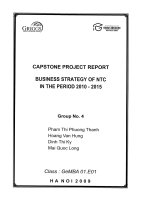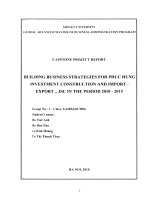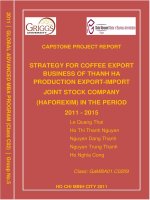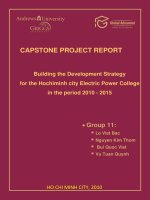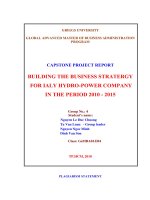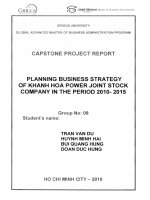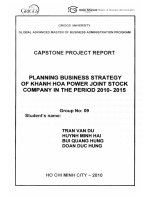Building business strategy at company level for HA NOI DIEN BIEN MINERAL AND RESOURCES COMPANY LIMITED in the period 2010 – 2015
Bạn đang xem bản rút gọn của tài liệu. Xem và tải ngay bản đầy đủ của tài liệu tại đây (392.06 KB, 69 trang )
LUẬN VĂN THẠC SĨ
THESIS TITLE
Building business strategy at company level for HA NOI - DIEN BIEN
MINERAL AND RESOURCES COMPANY LIMITED in the period 2010 –
2015”
GROUP VI
1
INDEX
Introduction................................................................................................................4
Chapter I: Theory basis on business strategy .........................................................6
I. Overview of strategic management..................................................................6
1.1 Business strategy..................................................................................................6
1.1.1 Origin of strategy and concept of business strategy.......................................6
1.1.2 Basic characters of strategy...........................................................................7
1.1.3 Roles of strategy in business...........................................................................8
1.2 Strategic Management..........................................................................................9
1.2.1 Definition of strategic management................................................................9
1.2.2 Meanings of strategic management................................................................9
1.2.3 Strategic management model .........................................................................10
II. Theory basis......................................................................................................11
2.1 Analysis of the environment within the enterprise..............................................11
2.1.1 Analysis manpower......................................................................................12
2.1.2 Analysis of the technical infrastructure and technology companies.............12
2.1.2.1Technology renovation.................................................................................12
2.1.2.2 Analysis of the infrastructure of an organization.......................................13
2.1.3 Analysis of the capacity of the company ......................................................13
2.1.4 Analysis of the capacity of the company.......................................................14
2.1.5 Analyze the Marketing activities...................................................................14
2.2 Analysis of competitiveness.................................................................................15
2.3 Analysis of Environment macroscopic................................................................16
2.3.1 Analysis of Legal and Political factors........................................................16
2.3.2 Analysis of the economic environment..........................................................17
2.3.3 Analysis factor in social and cultural...........................................................18
2.3.4 Analysis Factor in technological..................................................................19
2.4 Analysis of the environment sector....................................................................19
2.4.1 Analysis of competitor .................................................................................20
2.4.2 Analysis of customer pressure .....................................................................20
GROUP VI
2
2.4.3 Analysis of supplier pressure .......................................................................21
2.4.4 Analysis of new product pressure ................................................................21
Chapter II: Analysis of the current status of the enterprise.....................................23
I. Company prpofile..............................................................................................23
II. Function, obligation and strategic target........................................................23
2.1 Function of the company......................................................................................23
2.2 Strategic Target.....................................................................................................23
III. Analysis of internal evironment ....................................................................24
3.1 Analysis according to resources...........................................................................24
3.1.1 Organization structure of the Company ........................................................24
3.1.2 Human resource management........................................................................26
3.2 Technical and technological material base of the company................................29
3.3 Analyze company’s financial condition..............................................................30
3.4 Analysis of the manufacturing capacity of the enterprise ..................................33
3.5 Analyze the Marketing activities.........................................................................34
IV. Analysis of competitiveness............................................................................35
V. Analysis of environment macroscopic ..........................................................37
5.1 Analysis of Legal and Political factors. .............................................................38
5.2 Analysis of the economic environment................................................................39
5.2.1
Growth speed of the economy......................................................................39
5.2.2
Inflation.......................................................................................................39
5.2.3
Forex...........................................................................................................40
5.2.4
Interest rate.................................................................................................40
5.3 Analysis factor in social and cultural...................................................................40
5.4 Analysis Factor in technological..........................................................................41
VI. Analysis of the environment sector ..............................................................42
6.1 World metal mineral market.................................................................................43
6.2 Domestic mineral market.....................................................................................44
6.2.1 Evaluate sources of supply in the vietnamese market ..................................44
6.2.2
Estimation of market demand.......................................................................46
GROUP VI
3
6.3 Analysis of the environment sector.....................................................................48
6.3.1 Analysis of potential opponents....................................................................48
6.3.2 Analysis competitor present.........................................................................48
6.3.2.1Backan Mineral Joint Stock Corporation (BAMCORP)...............................49
6.3.2.2Hoang Bach Group......................................................................................49
6.3.2.3Thanh Hoa SD Xuan Minh Joint Stock Company.........................................50
6.3.2.4Bac Kan – Nikko Mineral Joint Venture ......................................................50
6.3.3 Analysis of customer pressure......................................................................53
6.3.4 Analysis of supplier pressure .......................................................................53
6.3.5 Analysis of new product pressure.................................................................53
Chapter III: Designing strategies and solutions for the implementation of the
strategies.....................................................................................................................57
I. Formulating strategies.....................................................................................57
II. Consideration of strategic target for the period from 2010 to 2015.............60
III. Major factors in the selected strategy..........................................................60
3.1 Market expansion.................................................................................................60
3.2 Investment, Process and Production....................................................................60
3.3 Strategy to develop its human resource ..............................................................61
3.4 Marketing Strategy...............................................................................................61
IV.Investment plan and inplementation process.................................................61
4.1 Actions to be taken for solution implementation.................................................62
4.2 Person in chare of solution implementation.........................................................62
4.3 Time for solution implementation : 5 years in total (From 2010 – 2015)...........63
V. Conclusion........................................................................................................67
List tables........................................................................................................68
List of the models............................................................................................69
List of reference materials...............................................................................70
GROUP VI
4
INTRODUCTION
Topic: “Building business strategy at company level for HA NOI - DIEN BIEN
MINERAL AND RESOURCES COMPANY LIMITED in the period 2010 –
2015”
1. Necessity of the subject:
In the history of the world has observed many people integrate the business world
with a small capital, but they were quickly then successful and gained victories and
victories thanks to the right business strategy. The business strategy is compared
with steering wheel of the ship that helps to come over the ocean to the destination,
particularly at the beginning time of its operation. It is also considered a gust of
wind that flies the kite higher and higher. Actually, experiences of successes and
failures in business have showed some billionaires are descended from bare hands
with tiny capital thanks to optimum business strategy,
vice versa some of
millionaires have to pass their fortune to their competitors in a short time due to
blunder in business method. Closing down of loss-making companies and
development of profitable enterprises really significultly depends on business
strategy of such companies, particularly in the market economy.
Origin of success or failure is dependent on one of the important factors, which is
what business strategy the company has.
Being aware of the importance in building the company Business Strategy , with the
knowledge gained from MBA course provided by ETC (Hanoi National University)
in association with Griggs University and study period in HA NOI - DIEN BIEN
MINERAL AND RESOURCES COMPANY LIMITED, our group would like to
choose the topic: “Building business strategy at company level for HA NOI DIEN BIEN MINERAL AND RESOURCES COMPANY LIMITED in the
period 2010 – 2015”
Purpose: With this topic, we wish to help the company have right track in the
coming period.
GROUP VI
5
2. Scope of research
The concentration of resources to the question on the development strategies of
HA NOI - DIEN BIEN MINERAL AND RESOURCES COMPANY LIMITED.
Analysis, to study the operation of the business of the company on the following
aspects: the function, tasks and inside and Outside and environment branch. Since
the strategy of business for a period of 2010-2015 and the solutions and specific
measures for the implementation of the strategies.
3. Methods of research
Capstone project report use of scientific methods: comparison and to sum up, the
method mark; the use of statistical data for the demonstration.
4. Thesis structure
Apart from the introduction and conlusion, large exercise of 3 of chapter:
Chapter I: Theory basis on business strategy
Chapter II: Analysis of the current status of the enterprise
Chapter III: Designing strategies and solutions for the implementation of the
strategies
GROUP VI
6
CHAPTER I
GENERAL THEORY BASIS ON BUSINESS STRATEGY
I. OVERVIEW OF STRATEGIC MANAGEMENT :
Motivated by increasing internationalization trend and scarcity of resouces, rainstorm development of technology, change of market demand, business environment
is becoming more and more complicated and fluctuant. Such business environment
requires the enterprise to have a good business strategy, so that it can catch the
opportunity, avoid risks, and ensure a stable and sustainable development.
1.1. Business strategy:
1.1.1. Origin of strategy and concept of business strategy
“Strategy” is a term originated from Greek language, “Strategos” which is used in
military, the modern military theorist Clawzevit reckoned: Military strategy is the
commanding art at the optimum advantage. A publication of Larous dictionary
considers: strategy is an art to commend all means to gain the victory.
Scholar Dao Duy Anh, in Vietnamese dictionary wrote: strategy is drawn plan to
achieve the victory on one or many battlefields. Therefore, in army aspect, strategy
term in general is considered a commanding art aiming at victory achievement in a
war.
In 1962, Chandler defined strategy as “determination of long-term basic target and
goal of the enterprise and application of actions series as well as allocation of
necessary sources to implement such targets” (Chandler, A. (1962). Strategy and
Structure. Cambridge Massachusetts. MIT Press).
Until 1980, Quinn introduced a more general definition “Strategy is a pattern or
plan which integrates essential goals, policies and action series into a firmly
consolidated general” (Quinn, J.B.1980. Strategies
for Change: Logical
Incrementalisn. Homewood, Illinois, Irwin).
Then, Johnson and Scholes redefined strategy in an environment with a lot of quick
changes: “Strategy is orientation and scope of an organization in long term to gain
its competition power through formulation of its sources in changing environment
GROUP VI
7
in order to meet market demand and satisfy shareholders” (Johnson, G.,Scholes, K.
(1999), Exploring Corporate Strategy, 5th Ed. Prentice Hall Europe).
A part from the above traditional approach, many business organizations approach
the strategy in a new way: business strategy is plan to control and use human,
properties and finance resources aiming to enhance and ensure the indispensable
rights. Kenneth Andrews was the first to offer these outstanding ideas in the
classical book "The Concept of Corporate Strategy!" He introduced that the strategy
is what an organization must rely on the strengths and weaknesses of theirs in the
context of both opportunities and threats.
Brace Henderson, strategist at the same time was the founder of Boston Consulting
Group connected the concept of strategy with competitive advantage. Competitive
advantage is setting a company in a better position than its competitor’s to create
the economic value for customers. "Strategy is a careful search for an action plan to
develop and combine competitive advantage of the organization. The difference
between you and your competitor is the basis for your advantage. He believed the
two competitors can not coexist if their business methods are identical. Difference
creation can enable the existence. Michael Porter also agreed with Henderson’s
judgment: "Competitive Strategy relates to differences. That is a careful selection of
a series of different activities to create an unique set of values”.
By what means of approach, nature of strategy is drafting the future image of the
enterprise in their activities field and operation capacity. According to this
understanding, business strategy term is used in 3 most popular meanings:
- Determination of long term goal of the enterprise
- Provision of the general action program
- Selection of action options, allocation of sources to implement such goal.
“Source: Chapter 1 – General view on Strategic Management
– National
Economic University”
1.1.2. Basic characters of strategy
- Strategy specifies clearly fundamental objectives, business directions to be obtained in
each period and is fully consistent thoroughly in the areas of operations management of the
GROUP VI
8
business. Orientation character of the strategy is to ensure business continuous and firmly
development in the usually fluctuated trading environment.
- Business strategy only drafts operation course of the enterprise in long term, and
operation framework of the enterprise in future. That is orienting only but in
practice, business activities require combination of strategic target and economic
target, taking into consideration of reasonability and adjusting to suit the
environment and condition of business to ensure the business efficiency and remedy
errors caused by orienting character of the strategy.
- Business strategy is built on basis of the enterprise competitive advantage to
ensure maximum mobilization and good combination with operation and use of
sources (manpower, asset power of both visible and invisible), core capacity of the
enterprise in present and in future aiming to promote Strengths, capture the chances
to obtain upper hand in competition.
- Business strategy is reflected in a continuous process from building up,
implementation organization, evaluation, inspection and adjustment of the strategy.
- Business strategy always carry attacking idea to gain victory in competition.
Business strategy is formed and realized based on identification and utilization of
business opportunities, competitive Strengths of the enterprise to achieve high
business efficiency.
- Every important strategic decision in the process of building-up, implementation
and adjustment of strategy is often focused to high rank managers group. To ensure
the correctiveness of long term decisions, information secret in competition is
important.
1.1.3. Roles of strategy in business
With the above characters, it is said that in market mechanism, building and
realization of business strategy has an important meaning for the enterprise
existence and development.
- The business strategy help the enterprise recognize its target of orientation in
future as guideline for all activities of the enterprise.
GROUP VI
9
- Business Strategy plays oriental role of the enterprise operation in long term, it is
the firm basis for deployment of activities. Lack of strategy or unclear strategy
without firm ground will make the enterprise lose the direction, problems arisen are
foreseen in short term not in long term or viewed partially not in whole operation
of the enterprise.
- Business Strategy will provide assistance to the enterprise in seizing and making
use of trading opportunities, simultaneously proceeding countermeasures against
threats in business market.
- Business strategy contributes to enhance efficiency of sources usage, intensify
company position to make sure of uninterrupted and unshakeable development.
- Business strategy creates strong base for the enterprise to make decision suit the
market changes. It gives firm basis for activities of research and development,
investment to personnel training and improvement, market widening and product
development. In fact, almost mistakes in investment, technology, and marketing…
are in consequence of building wrong strategy or wrong target.
1.2. Strategic Management
1.2.1. Definition of strategic management
Some definitions of strategic management:
- Strategic management is a group of decisions and actions to decide the long term
success of the Company.
- Strategic management is a group of decisions and measures to make plans and
implement strategies to realize targets of the Company.
- Strategic management is to study existing and future conditions and to make plans
for targets of the Company; to organize and check the implementation of decisions
to realize targets in both existing and future conditions.
1.2.2. Meanings of strategic management
- Help to realize, give priorities and obtain opportunities
- Point out real opinions and views on difficulties of management works.
- Put forward an outline for the synchronous development of activities and control
- Minimize risks
GROUP VI
10
- Help to have major decisions serving the preparation of targets.
- Help to have better arrangement of time and resources for specific opportunities.
- Reduce time and resources necessary to correct mistakes and wrong decisions.
- Create a framework for relationships among individuals within the Company.
- Help to combine individual actions into a common effort.
- Create a basis to specify responsibilities of each individual.
- Bring about an encouragement for good and progressive opinions.
- Create means of cooperation, attachment, passion in jointly solving problems and
obtaining opportunities.
- Encourage active manners to changes.
- Bring about an official discipline in the Company.
1.2.3. Strategic management model
Strategic management process is often studied and used through models.
The strategic management model created by F. David is popularly accepted. This
model does not ensure the success but provides a clear and basic approach in
preparation, implementation and evaluation of strategies. The Relationship among
steps of the strategic management process is presented in Figure 1.1
Evaluate external
factors, point out
opportunities and
challenges
Point out
existing
tasks,
targets
and
strategies
Set up long
term targets
Set up
normal
targets
Review
tasks of
the
Company
Evaluate internal factors,
point out strengths and
weaknesse
Distribute
resources
The choice of
strategy for
according to to
Formulating
strategies
Measure
and
evaluate
the
impleme-ntation
Policy unit
Implement
strategies
GROUP VI
Assess strategies
11
Model 1.1: Strategic management model of F. David
“Source: Chapter 1–General of Strategic Management–National Economics
University”
The Outline of tasks, targets and strategies of a Company is the firstly logic and
necessary step in the strategic management because the existing position and status
of the Company could prevent the Company from applying some strategies and
even prevent the Company from series of works. Each Company has its own tasks,
targets and strategies though these tasks, targets and strategies are prepared, and
published unintentionally. The answer for the future position of the Company will
be mainly decided by its current position.
II.
THEORY BASIS:
2.1 Analysis of the environment within the enterprise
Purpose to identify strong and weak points which allow the enterprise to determine:
What we can do?
Based on the determination of company sources and core capacity, from that
appropriate measures for the company strategy will be given in compliance with
external conditions.
* Company core capacity:
- Special production skills with high quality
- Provision of after-sales service
- Low production cost
- Advantagous location of retailing system
- New technology for product development
- High professional sale representatives, etc.
* Internal sources of the enterprise
Those are input factors of production and trading process including visible and
invisible sources.
* Model of value chain analysis (by M.Porter, 1985 )
In this value chain, Porter’s model divided into two main aspects of business:
supplementary and key activities. Basically, there are generally nine types of
GROUP VI
12
activities which creat value in the whole chain. Group of key activities consists line
of five types of activities: input the materials to trade; operation, production-trading;
transportation outwards; marketing and sale; providing relating services.
Supplementary group contains activities which make value including: infrastructure,
human resources administration, technology and procurement. Supplementary ones
occur inside each key activity.
2.1.1 Analysis manpower
In the way of the creation of the competitiveness of companies, the advantage
through human rights is a fundamental factor. Human being is reckoned as essential
source and possess decisiveness thoughout ages. Resources from the human factor
is sustainable and difficult to change in any organization.
Capacity through manpower in company is understood as capacity of the company
employees team. This capacity is shown in aspects of figure 1.3. Human resource
contributes to success of the company in respects of high quality, excellent services,
innovation ability; skills in specific works; and capacity of employee team. This is
the core factor to bring about the sucess for the organization. However, not every
organization can achieve sucess in all aspects on manpower and normally they
choose focuses suitable to the company vision and strategy.
Paying attention to labor is the best way to stick them to the company. Researches
will demonstrate thoughts, attitude and indicators of changes in their works, from
those, countermeasures of the company will be drawn out. Consistent, effective and
courageous management will bring sucessfull efficience better than expected. The
company has to confirm number of employee and their relative capacities can match
with position and function of the current work or not?
Therefore, in long term, the company, organiztion has to control the employment,
selection, training-upgrading, and complimentary. Tasks and targets of the
organization will be carried out in parallel with an efficient HR strategy.
2.1.2 Analysis of the technical infrastructure and technology companies
2.1.2.1 Technology renovation:
GROUP VI
13
For production process, arrangement of machinary must be evaluated carefully. It
will affects on suitability in transportation, storage, smoothness of the system, the
synchorous machinery. Therefore, personnel who carry out the production
administration must answer: How appropriate the machine and equipment
arrangement in the company is now?
Motivation of technology innovation differs from motivation of innovation and
improvment of products of which market widening is the main target, while
technology innovation is with purpose of cost reduction or product quality rising.
Technology innovation does not always require research of basic technical science,
but it demands competences to exploit new science achievements.
2.1.2.2 Analysis of the infrastructure of an organization.
This activity is controlled by the whole team, organization or strategic plan,
including MIS, equipments and machines for implementation and monitoring them.
It like an accounting department. The enterprise has to maintain following elements:
- Organization structure, prestige and enterprise image
- Enterprise scores to achieve goals
- Communication system setting
- General organization monitoring system
- Atmostphere of organizational order
- Capacity, level of attention and qualification of the highest management board
- Strategic planning system
2.1.3 Analysis of the capacity of the company
Financial analysis enables enterprise in determination of its strengths and weakness.
It also identifies causes and gives solutions for that issue. The enterprise can only
exist and bring in more wealth to its owner if its finance is well managed.
Therefore, in any scale, big or small, the enterprise should focus on financial
management. In order to implement the enterprise business assignments, financial
management activity does not taken independantly but related to other functions
such as production, marketing, administration, human resource. During analysis of
enterprise finance, it is required to conduct following steps: Selecting criteria to be
GROUP VI
14
evaluated; identifying those criteria; comparing with the past’s criteria and common
criteria in the business field as well as competitor’s criteria.
2.1.4 Analysis of the capacity of the company
During business development, enterprises spend great efforts to achieve market
advantage such as expansion of production scale, gained experience... in order to
reduce product price and increase competition of the product in the market; final
goal is to increase turnover and profit for the enterprise. Or enterprises carry out
improvement of their machinary, motivate development research aiming to promote
products having different functions to sastify customers’ demand. Though the
enterprise has to invest big amount for this method but owning to the difference of
product, consumers are willing to pay high price for it. Thus, the enterprise are still
able to maintain its position in the market.
Production function in business operation is a process of making inputs into goods
and service. For almost businesses, major production cost to creat goods and service
makes up large ratio in company costs. The enterprise should determine: What to be
produced? How is quantity? Where to be comsumed? And when to be produced?
So, the enterprise should establish production plan, material reservation and supply
plan and product reservation and provision plan...
Therefore, production function is often considered as a competition weapon in the
company strategy.
2.1.5 Analyze the Marketing activities
As definition of American Marketing Association: ”Marketing is performing
business activities in order to transfer goods and services from manufacturers to
consumers or users“.
Marketing plays an important role in decision and coordination of integration of
enterprise’s business activities and market; ensures business activities of enterprise
following the market, which consider the market and consumer’s demand the basis
for business decision-making. To analyse marketing performance in business, we
need to forcus on matters of analysing customer, purchasing and selling acitivities,
product and service strategies, price making, distribution, marketing study,
GROUP VI
15
opportunities and social obligation. From such analysis, we must consider if
marketing staff, who mainly perform marketing tasks, make a future market
prospects with newly arising consuming trends and which trend will dominate the
market. Marketing attitude nowadays will strongly decide the company’s position in
the future. Consequently, the system’s addtitute in term of responsibility toward the
consumer will proberly play a key role in making decision.
2.2 Analysis of competitiveness
Companies pursue strategic businesses to achieve more competitive
Strengths than their
competitors’ and consequently gain an income higher than the average level. These strategic businesses are: Leading in cost saving,
product differentiation and concentration.
Leading in cost
saving
(mainly
Product
Concentration
differentiation
by High (mainly by From low to high
Product
Low
differentiation
Market
price)
Low (mass market)
segment
Specific ability
Production
the uniqueness)
(price or uniqueness)
High
(many Low (one or some
market segments) market segments)
and R&D, Marketing Any specific ability
material management
and Sale
Model 1.2: Three competitive strategy of basic M.Porter
“Source: Chapter 6 – General of Strategic Management–National Economics
University”
⇒ Assess the competitive capacity of the whole enterprise
Business must find out its strong point that it’s performance is better than other
competitors. Such strong points that the competitors cannot copy or adopt simply.
Overall frame of building business competitive Strengths is as below:
GROUP VI
16
Good quality
Competitive advantages:
High
- Low cost
productive
Consumer’s
good feedback
- Difference
Innovation
Model 1.3: Core competitive capacity
“Source: International Business Management – Commercial University”
From comments and analysis of business’s internal and external factors, we build
matrix SWOT (identify weak point, strong point, opportunity, challenging) to
determine the suitable strategy to be executed.
2.3 Analysis of Environment macroscopic
It is an environment containing huge factors that affect to long term strategical
decision of business. For example: economical, political, cultural, law factors, etc.
2.3.1 Analysis of Legal and Political factors.
Elements of political influence and great to the operations of enterprises. They can
create opportunities and obstacles even real risk to the enterprise for a change of
political. For example:
- Political stability.
- Role of Government and its attitude to international trading and business.
- Law system.
- Lawcourt system.
In the business operation of the enterprises shall have to take action from all sides
that the relevant policies of the state such as: antitrust law, tax laws, the option to
adjust or priority, labour legislation and policies to manage the state can affect
activities and the profitability of industry or business.
GROUP VI
17
The interests of enterprises and consumers of an enterprise must comply with the
policies of the decree of the state and have advanced according to the operation of
the enterprises themselves.
2.3.2 Analysis of the economic environment
Economic factors can change value and turnover of the enterprise, such as: balance
of trade, foreign investment, market orientation, monetary system, distribution of
income and purchasing capacity, inflation, economic development, infrastructure
and natural resources. Specifically:
- Economic environment shows nature and direction of an economy in which the
enterprise operates its activities. Such definition of economic environment in
present condition should be relatively understood, since intergration of countries in
over the world as a result of a global economy, thus the business itself needs to
inspect, observe, calculate cost estimation and assess economic healthy of the
overseas economy.
- National balance of trade shows advantage fields of a country.
- Inflation can reduce stability of an economy and cause slow economic growth,
higher interest and unstable exchange rate variation. If the inflation increases,
making a business plan becomes high risk. A key feature of inflation is that it makes
future forecast very difficult.
- Investiment in morderation of companies in case of increasing inflation will
slowdown economic activities, then at last put them to come into deadlock.
Consequently, high inflation is certaintly a threat to company.
- Economic growth leads to an outbreak of expenses of consumer, thus it can make
a more comfortable trend of competitive pressure in the same field. This brings
opportunities to companies to expand their business and obtain higher profits. In
contrast, economic decline will lead to decreasing consumption, as a result,
competitive pressure is increased. Also an declined economy normally causes price
wars in saturated fields.
- Monatory system is indicated through national applicable currency and the
exchang rate, which defines value of currency of different countries. Exchange rate
GROUP VI
18
variation directly impacts to competitiveness of companies in global market. For
example, when value of domestic currency is lower than other foreign currencies,
domestic products will be relatively cheaper than foreign products. Low or down
value of domestic currency will reduce threats from foreign competive companies,
in the meanwhile, it creates opportunities for increasing export turnover.
2.3.3 Analysis factor in social and cultural
Culture is a complicated concept. Culture is considered as an objective existance in
human society. Each of person, manager or organization belongs to a curtain
culture. Moral, belief, system of values of each individual is built and grown under
each culture. Similarly, business strategy is also affected by culture, it controls
consumer’s behaviour and customer’s buying attitute.
Society is a colorful picture created by individual with different life styles. It is this
to control strongly the formation of demand of type, quality, quantity, shape, sample
etc of products or services characterising that life style. Thus managers, unless
adjusting their activities to catch up with life style of both current and future
society, they hardly to make a good business. The factors are as follows:
- Social organizations
- Values and criteria
- Language and religion
- Population with growth rate and aging structure.
Normally, in each business, manager has to analyse population structure by gender,
age to phase and determine the target market. That means, by such analysis, they
can identify the actual demand of their products, then make decision of production
and consumption plan of their business.
- Urbanization speed
- Fact and business behaviour
Population movement from one area to another area is also a factor affecting to
making strategic plan and human resources management, marketing stretagy and
other supporting business plan acting in the existing business environment.
- Professional Capacity
GROUP VI
19
Social labor specialization and cooperation is an indispensable in development
process of each country, region and all over the world. Obviously we can see that,
the significant economic development, labor specalization and cooperation is
extreamly high and vice verce. This also means that professional specialization and
cooperation is stronger and stronger in a developed society. Besides, people having
different consumption demands of food, accommodation, travelling and
entertainment because of their different professions. In order ton meet demand of all
kinds of profession in the society, managers must consider all impacts of such
factors on their business plan and strategy.
Population and population growth in each market and each nation, as always, is
factor that causes dramatical affection to all business administration of each
company.
2.3.4 Analysis Factor in technological
Of course, technology alternation will affect to life circle of a product or service. A
theorical cycle consists of starting, growth, mature and vanish. There is the fact that
after the vanish stage, some products will have a new growth. Moreover, technology
alternation also affects to production method, materials as well as labor’s
behaviours. Thefefore, this is factor with significant and direct affection to business
strategy of many companies and many sectors. The 21 century is a century of
science and information technology, therefore, analysis and prediction of
technology alternation is very important and urgent ever, as following indications:
- Scientific and technology criteria
- Technological effort
- Protection of invention cerficaiton
- Technology transferring
- Automation
- Decision for development, and the conditions for the application of new
technologies, modern.
2.4 Analysis of the environment sector
GROUP VI
20
It is an enviroment in which the business is performing their business activities,
including a set of elements directly affecting to business, and also affected by the
business. For example: supplier, competitor, customer, etc.
There is a analysis model may the force be M.Porter construction helped the
seasons the strategy in the analysis of this. The model presented a model of 1.4
Threat of new
Entrants
Competitive
rivalry within an
industry
Bargaining
Power of
Customers
Bargaining
Power of
Suppliers
Threat of Substitute
Products
Model 1.4: Five-forces model
“Source: Chapter 3 – General of Strategic Management–National Economics
University”
2.4.1 Analysis of competitor
Competitors are companies that their business providing similar products, that’s
means they satisfy the same demand of customers in the market.
Competitor consists of actual competitor and potential competitor.
If the sector competition is weak, company will have oppotunity to pump up price
and get more profits. However, if the competition is high, highly price competition
will lead to a price war. The competition will restrict profitability due to reduce of
marginal profit per turnover. Thus, competition strength among companies of the
same business type will generate a big threat to the profitability. In summary, rate of
competition among companies of the same business type will depend on three main
factors: sector competitive structure, demand condition and high take-out barrier.
2.4.2 Analysis of customer pressure
GROUP VI
21
Second one of the five forces of Porter is buyer’s negotiation capacity. Buyer of a
company can be last user or they can be distribution agency who deliver the
product, so-called wholesale agency and retail saleman. To achieve target turnover,
business must deliever its products to the consumer, therefore, customer plays a key
role in success and reputation of a company. Nowadays, a business must supply
products that meet customer’s demand instead of selling their available products.
2.4.3 Analysis of supplier pressure
Supplier can be considered a threat to a company when they press price increasing
or to reduce company’s profitability. In contrast, it it is a weak supplier, it will
create a chance for the company to press price decreasing and require high quality
products. The same with buyer, supplier’s requirement to the company will depend
on their relative power on the company. According to Porter, supplier’s power is
highest as: their product is limited, alternativable and important to the company.
2.4.4 Analysis of new product pressure
Replaced products are products serving for customer’s demand, similarly to the ongoing analyis business type. Existance of replaced products reveals a competitive
threat, it restricts high pricing, therefore there is limit for company’s profitability.
However, if the company has limited replaced products (in case weak competitive
products) and other normal factors, that company will have chance of increasing
price and getting higher profit. As a result, company’s strategy will be designed to
gain competitive advantage from this fact).
External Factor Assessment Sample EFAS
Step 1: Define and set a list of 10-20 factors (opportunities and threats) which play a
key role in success of the company.
Step 2: Giving assessment of importance of each factor by rating from 1.0 to 0.0 on
the basis of each factor’s impacts (rate, time) on the current business strategy of the
compnay. Suitable rating can be defined by making comparison of sucessful
competitve companies and unsuccessful ones. Total of this figures equivant to1.
Step 3: Giving assessment of each factor by rating from 4(outstanding) to 1 (bad) on
the basis of the company’s current strategy orientation reacts to this factors. So, this
GROUP VI
22
rating is for individual company, while rating at step 2 is by sector.
Step 4: Multiply importace rate of each factor with its score to determine
importance score of each factor.
Step 5: Plus importance score of all external factors to determine total of importance
score of the company. Total of importance score from 4.0 is good, 1.0 is bad and 2.5
is average value.
GROUP VI
23
CHAPTER II:
ANALYSIS OF THE CURRENT STATUS OF THE ENTERPRISE
I.
COMPANY PROFILE
In Febuary 2008, Hanoi-Dien Bine Minerals and Resources Co. Ltd Minerals and
Resources Company Ltd was established based on the Business License No.
62040000025 dated 6/3/2008 .
Trade name:
HA NOI - DIEN BIEN MINERAL AND RESOURCES
COMPANY LIMITED
Shorten form :
TAINGUYEN COPR
Email:
Address: No. 101, group 10, Nam Thanh Ward, Dien Bien City
Telephone:
0230.3867171
Fax: 0230.3867171
Business activity:
+ Minerals exploration, process and trading.
+ Real Estate Agency
+ Real Estate Trading. ..
II.
FUNCTION, OBLIGATION AND STRATEGIC TARGET
2.1 Function of the company:
The company has function of Lead – nickel silver investigation and exploration in
area of Xa Nhe Commune, Mun Chung commune, Tuan Giao District, Dien Bien
Province.
2.2 Strategic Target:
Invest to diversify product, increasing quality of product in order to build up
sustainable development for the company and meet customer’s demand better and
better.
Concentrating on setting out Marketing strategy to be strongly competitive when the
market expands for rising up quality of exported goods.
Strengthening management organization model to enhance management efficiency
for development of the Company in the coming time.
GROUP VI
24
Building a professional enterprise, cooperation to develop and take Strengths of
local and foreign partners, obtain opportunities to expand its market to the regional
countries.
In the next year, the Company will expand its share in the domestic market,
especially in Cities with industrial zones. Further more, the Company will pay much
attention to foreign clients from China, South Korea, Taiwan, Japan, India, etc.
III.
ANALYSIS OF INTERNAL EVIRONMENT
Internal environmental will be analyzed based on organization structure and
together with supporting centers to implement parts of works as the below chart:
ORGANIZATION INFRASATRUCTURE
HUMAN RESOURCES MANAGEMENT
TECHNOLOGY DEVELOPMENT
PURCHASING MANAGEMENT
Input
Logistics
Exploration Production
Output
Customer
of raw
Processing Logistics Marketing and
care
Sales
materials
Model 2.1. Implementation process and Chain of value
3.1 Analysis according to resources:
3.1.1 Organization structure of the Company
Since the Company was just established in February 2008, its organization structure
is step by step adjusted. The company’s organization structure is shown in model
2.1. Current organization structure of the company is a combination of Functional
Online Organization and Associated Matrix Organization. In which, the Functional
Online Organization is used for high level (management) and the Associated Matrix
Organization is used for low level (execution). With this organization mode, the
company obtains centrally control and ensures rapid decision making for execution
and limit shortcoming of unique functional online organization model.
GROUP VI
25
